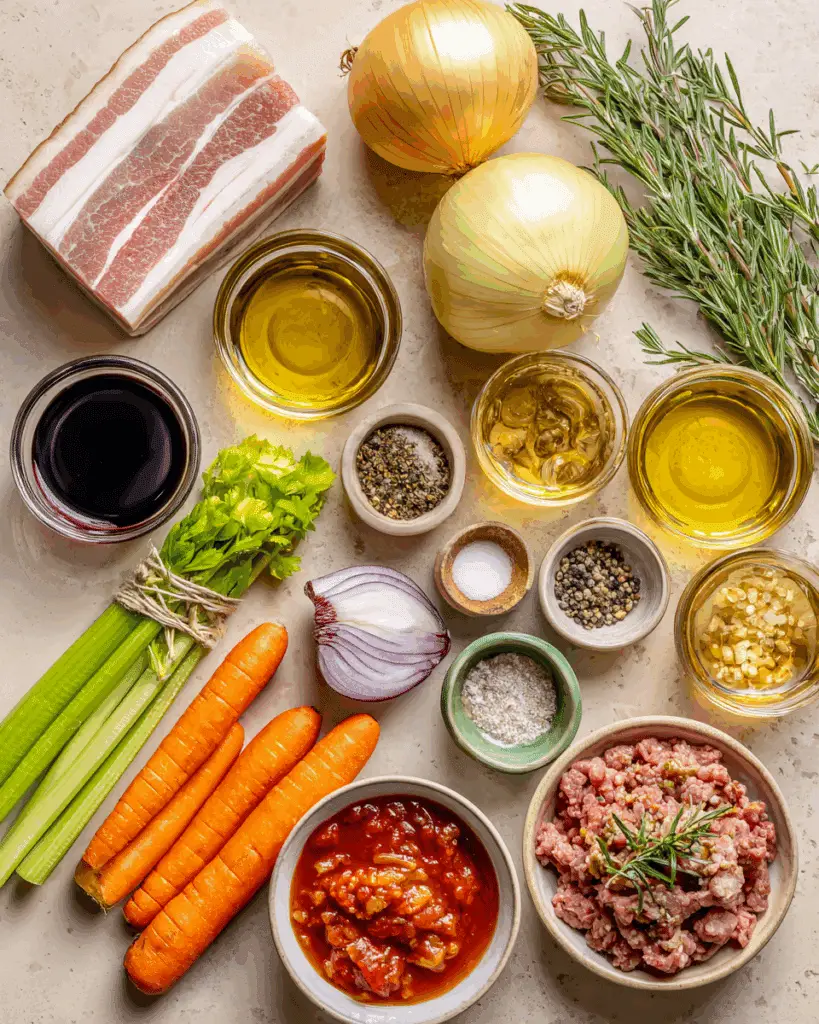If there’s one sauce that instantly makes pasta feel indulgent and comforting, it’s a classic Italian ragu. This slow-simmered meat sauce is rich, savory, and full of depth, with tender morsels of beef and pork belly mingling in a tomato-forward base. The aroma alone—onions, carrots, celery, garlic, and a splash of wine—will fill your kitchen and make your stomach growl. Every bite tastes like a hug in a bowl, perfect for draping over spaghetti, fettuccine, or even creamy polenta. This recipe is both authentic and approachable, bringing a little taste of Italy straight to your home kitchen.
Disclosure: This post contains affiliate links.If you click and make a purchase, I may earn a small commission at no extra cost to you.
Why You’ll Love This Recipe
This ragu sauce is more than just pasta dressing; it’s a slow-cooked masterpiece that elevates any meal. Here’s why it’s so special:
Deep, Complex Flavor: The pork belly adds richness, the wine adds brightness, and the combination of aromatics creates a sauce that’s savory and layered.
Comforting and Hearty: Thick, meaty, and satisfying, this sauce is perfect for cozy dinners, family meals, or any time you crave Italian comfort food.
Versatile: Serve it over your favorite pasta, use it in lasagna, or spoon it onto polenta or roasted vegetables.
Simple Ingredients, Big Results: You don’t need fancy items to make it taste like it came from an Italian trattoria.
Recipe Origin
Ragu is a traditional Italian meat sauce, originating from Northern Italy. Slow-simmered with a combination of meat and vegetables, it’s meant to be hearty, flavorful, and versatile. This version uses pork belly for extra richness and beef for classic flavor, creating a balanced, authentic taste.
Kitchen Tools You’ll Need
A large sauté pan or Dutch oven, a sharp knife, cutting board, wooden spoon or spatula, and measuring spoons.
Ingredients in Ragu Sauce
Pork Belly: Adds fat and richness that infuses the sauce with a deep, savory flavor.
Yellow Onion: Sweet and aromatic, it forms the flavor base of the sauce.
Carrots: Provide natural sweetness and balance the acidity of the tomatoes.
Celery: Adds earthy undertones and classic Italian soffritto flavor.
Extra Virgin Olive Oil: For sautéing vegetables and enriching the sauce.
Minced Beef: Provides hearty flavor and substance to the sauce.
Red Wine: Adds acidity, depth, and complexity; white wine is optional if you prefer a lighter flavor.
Tomato Passata or Crushed Tomatoes: Creates a smooth, rich tomato base for the sauce.
Salt and Black Pepper: Essential for seasoning and enhancing all the flavors.
(Note: the full ingredients list, including measurements, is provided in the recipe card directly below.)

Instructions
Step 1: Prepare the Vegetables: Finely dice the onion, carrots, and celery to create a classic soffritto base. This mixture will slowly release flavor into the sauce as it cooks.
Step 2: Render the Pork Belly: Heat olive oil in a large sauté pan or Dutch oven over medium heat. Add the pork belly slice and cook until it renders some fat and begins to brown slightly. Remove the pork if needed, leaving the rendered fat in the pan.
Step 3: Sauté Aromatics: Add the diced onion, carrots, and celery to the pan. Cook, stirring occasionally, until softened and fragrant, about 5–7 minutes.
Step 4: Brown the Beef: Add the minced beef to the vegetables. Cook until browned and cooked through, breaking it up with a spoon as it cooks.
Step 5: Deglaze with Wine: Pour in the red wine, scraping up any browned bits from the bottom of the pan. Allow the wine to reduce slightly, concentrating its flavor.
Step 6: Add Tomatoes and Simmer: Stir in the tomato passata or crushed tomatoes, return the pork belly if removed, and season with salt and black pepper. Reduce the heat to low and let the sauce simmer gently for 30–45 minutes, stirring occasionally. The sauce should thicken and flavors will meld beautifully.
Step 7: Adjust Seasoning and Serve: Taste and adjust seasoning as needed. Remove the pork belly if desired or leave it for extra texture. Serve hot over cooked pasta, polenta, or use as a filling for lasagna.
Chef’s Pro Tips for Perfect Results
- Use fresh, high-quality tomatoes or passata for the best flavor.
- Simmer gently; high heat will toughen the meat and reduce flavor complexity.
- Stir occasionally to prevent sticking and ensure even cooking.
- Allowing the sauce to sit for a few hours or overnight enhances the flavor even more.
Nutrition Facts
Servings: 4
Calories per serving: 340
Preparation Time
Prep Time: 15 minutes
Cook Time: 45 minutes
Total Time: 1 hour
How to Serve Ragu Sauce
Serve the sauce over al dente pasta like tagliatelle, pappardelle, or spaghetti. It also works beautifully as a base for lasagna or spooned over creamy polenta. Garnish with freshly grated Parmesan cheese and a sprinkle of chopped parsley for a classic Italian touch.
Make-Ahead and Storage Tips
Ragu is even better the next day once the flavors have melded. Store in an airtight container in the fridge for up to 3 days. It can also be frozen for up to 2 months. Reheat gently on the stovetop over low heat, adding a splash of water or broth if necessary to loosen the sauce.
Variations to Try
- Add a splash of cream at the end for a richer, velvety sauce.
- Use a mix of beef, pork, and veal for a traditional Bolognese-style ragu.
- Include finely chopped mushrooms for extra depth and umami.
- Add a pinch of nutmeg or smoked paprika for a subtle flavor twist.
Additional Tips
- Chop vegetables uniformly to ensure even cooking.
- For a smoother sauce, use an immersion blender briefly at the end.
- Pair with rustic bread to mop up every last drop of sauce.
FAQ Section
Q1: Can I use only beef or only pork?
A1: Yes, but the pork belly adds richness that makes the sauce extra flavorful.
Q2: Can I use canned diced tomatoes instead of passata?
A2: Yes, but passata will give a smoother texture.
Q3: Can I make this vegetarian?
A3: Swap the meat with finely chopped mushrooms, lentils, or a plant-based meat substitute.
Q4: Can I prepare it ahead of time?
A4: Absolutely. Make it a day in advance; it tastes even better the next day.
Q5: Can I freeze ragu?
A5: Yes, for up to 2 months. Defrost overnight in the refrigerator before reheating.
Q6: What pasta works best?
A6: Long, flat pasta like pappardelle or tagliatelle captures the sauce best, but spaghetti works too.
Q7: Can I add fresh herbs at the end?
A7: Yes, a sprinkle of parsley or basil brightens the flavor beautifully.
Q8: How do I prevent the meat from drying out?
A8: Simmer gently on low heat and avoid overcooking.
Q9: Can I use white wine instead of red?
A9: Yes, white wine creates a slightly lighter, brighter sauce.
Q10: Should I remove the pork belly before serving?
A10: Optional. You can leave it in for texture or remove it after simmering.
Conclusion
This Ragu Sauce is rich, comforting, and packed with flavor. It’s a versatile Italian classic that elevates pasta, polenta, or lasagna into something extraordinary. The combination of tender meat, aromatic vegetables, and tomato-forward sauce makes it a family favorite and a go-to for weeknight dinners or special occasions. Simmer, serve, and savor every bite—it’s Italian comfort food at its finest.

Ragu Sauce (Italian Meat Sauce)
- Prep Time: 15 minutes
- Cook Time: 1 hour
- Total Time: 1 hour 15 minutes
- Yield: 4 servings 1x
- Category: Sauce, Main Course
- Method: Simmering
- Cuisine: Italian
- Diet: Low Salt
Description
Ragu Sauce is a rich and savory Italian meat sauce made with pork belly, minced beef, and aromatic vegetables, simmered slowly with wine and tomato passata. Perfect for pasta, lasagna, or as a hearty sauce for polenta.
Ingredients
- 1 thick slice pork belly, about 3.5 ounces
- 1 large yellow onion
- 2–3 small carrots
- 2 celery stalks
- 2 tablespoons extra virgin olive oil
- 10.5 ounces minced beef
- 3/4 cup red wine (or white wine if preferred)
- 2 cups tomato passata or crushed tomatoes
- 1 teaspoon salt, or to taste
- 1 teaspoon black pepper
Instructions
- Finely dice the pork belly, onion, carrots, and celery.
- Heat olive oil in a large saucepan over medium heat. Add the diced pork belly and cook until it starts to render fat and becomes lightly browned.
- Add the onion, carrots, and celery. Sauté until the vegetables are soft and aromatic, about 5–7 minutes.
- Add the minced beef and cook until browned, breaking it apart with a spoon.
- Pour in the wine and let it simmer until mostly evaporated, about 3–5 minutes.
- Add the tomato passata, salt, and pepper. Stir to combine.
- Reduce heat to low and simmer gently for 45–60 minutes, stirring occasionally, until the sauce thickens and flavors meld.
- Adjust seasoning to taste before serving over pasta, polenta, or using in lasagna.
Notes
- For a richer flavor, use a mix of pork belly and beef.
- Simmering the sauce slowly enhances the depth of flavor.
- Can be made ahead and stored in the refrigerator for up to 3 days or frozen for up to 2 months.
- Add a splash of milk or cream at the end for a smoother, richer sauce if desired.
Nutrition
- Serving Size: 1 cup
- Calories: 320
- Sugar: 6 g
- Sodium: 360 mg
- Fat: 18 g
- Saturated Fat: 6 g
- Unsaturated Fat: 10 g
- Trans Fat: 0 g
- Carbohydrates: 12 g
- Fiber: 3 g
- Protein: 28 g
- Cholesterol: 85 mg





9xr773
d4sux7